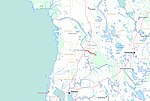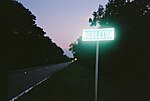Florida National Cemetery
1988 establishments in FloridaAll accuracy disputesBuildings and structures in Sumter County, FloridaCemeteries established in the 1980sCemeteries in Florida ... and 4 more
Monuments and memorials in FloridaProtected areas of Sumter County, FloridaTourist attractions in Sumter County, FloridaUnited States national cemeteries

Florida National Cemetery is a United States National Cemetery located near the city of Bushnell in Sumter County, Florida. Administered by the United States Department of Veterans Affairs it encompasses 512.9 acres (207.6 ha) and began interments in 1988. It is now one of the busiest cemeteries in the United States.
Excerpt from the Wikipedia article Florida National Cemetery (License: CC BY-SA 3.0, Authors, Images).Florida National Cemetery
CR 476B,
Geographical coordinates (GPS) Address Nearby Places Show on map
Geographical coordinates (GPS)
| Latitude | Longitude |
|---|---|
| N 28.605833333333 ° | E -82.21 ° |
Address
CR 476B 10288
33513
Florida, United States
Open on Google Maps








